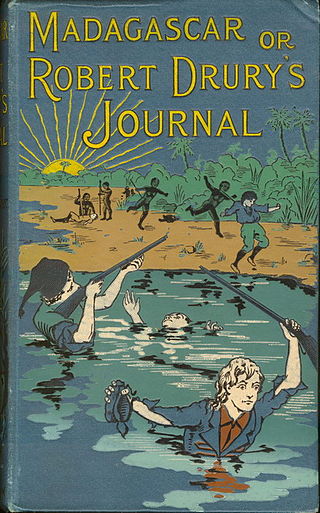Related Research Articles

The Life, Adventures and Piracies of the Famous Captain Singleton is a novel by Daniel Defoe, originally published in 1720. It has been re-published multiple times since, some of which times were in 1840 1927, 1972 and 2008. Captain Singleton is believed to have been partly inspired by the exploits of the English pirate Henry Every, who operated in the late 17th century.

Nosy Boraha, also known as Sainte-Marie, main town Ambodifotatra, is an island off the east coast of Madagascar. The island forms an administrative district within Analanjirofo Region, and covers an area of 222 km2. It has a population estimated at 30,000.
Jeremiah Cocklyn, better known by the name Thomas Cocklyn, was an English pirate known primarily for his association with Howell Davis, Olivier Levasseur, Richard Taylor, and William Moody.
Adam Baldridge was an English pirate and one of the early founders of the pirate settlements in Madagascar.

John Halsey was a British privateer and a later pirate who was active in the Atlantic and Indian Oceans during the early 18th century. Although much of his life and career is unknown, he is recorded in A General History of the Pyrates which states "He was brave in his Person, courteous to all his Prisoners, lived beloved, and died regretted by his own People. His Grave was made in a garden of watermelons, and fenced in with Palisades to prevent his being rooted up by wild Hogs."

Robert Drury was an English sailor on the Degrave who was shipwrecked at the age of 17 on the island of Madagascar. He would be trapped there for fifteen years.

Thomas Howard was a pirate primarily active in the Indian Ocean and the Red Sea during the Golden Age of Piracy. He served under other pirates of the time, including George Booth and John Bowen. He also commanded the 36-gun Prosperous. He later retired to Rajapur, in India, where he married a local woman. He was later murdered by her relatives.

Saint Augustin is a rural municipality in Madagascar. It belongs to the district of Toliara II, which is a part of Atsimo-Andrefana Region. The population of the commune was estimated to be approximately 15,000 in 2001 commune census. The mouth of the Onilahy River is near the town.

Van Tuyl is the surname of the Dutch family from which many North American Van Tuyls, Van Tuyles, Van Tyls and Van Tyles are descended. The family name derives from the ancient village of Tuil (Tuijl), in the central Netherlands. The family's earliest proven ancestor is the 14th-century knight Heer Ghijsbrecht van Tuyl of Gelre. This family is distinct from the Van Tuyll van Serooskerken family.

Abraham Samuel, also known as "Deaan Tuley-Noro" or "Tolinar Rex", was a mulatto pirate of the Indian Ocean in the days of the Pirate Round in the late 1690s. He was said to be born in Martinique or Jamaica, or possibly or Anosy, Madagascar. Shipwrecked on his way back to New York from Madagascar, he briefly led a combined pirate-Antanosy kingdom from Fort Dauphin, Madagascar, from 1697 until he died there in 1705.
John Benbow was an English traveller, who wrote an early account of Madagascar after running aground and being captured there.
John Hoar was a pirate and privateer active in the late 1690s in the Red Sea area.
Thomas Mostyn was a sea captain and slave trader active between New York and the Indian Ocean, and later in the Caribbean. He was one of the traders employed by New York merchant Frederick Philipse to smuggle supplies to the pirates of Madagascar.
John Swann was a minor pirate in the Indian Ocean, known almost entirely for speculation about his relationship with Robert Culliford.
John Cornelius was an Irish pirate allegedly active in the Red Sea and off the west coast of Africa. He succeeded William Lewis, who was killed after announcing he had made a deal with the Devil. Lewis and Cornelius are likely the fictional creations of Captain Charles Johnson, who presented their stories among those of real historical pirates.
David Williams was a Welsh sailor who turned pirate after being abandoned on Madagascar. He was only briefly a captain, and is best known for sailing under a number of more prominent pirate captains.
Thomas Collins was a pirate active in the Indian Ocean. He is best known for leading a pirate settlement and trading post on Madagascar.
John Rivers was a pirate best known for leading a settlement and trading post on Madagascar.

Giles Shelley was a pirate trader active between New York and Madagascar.
Edward Welch was best known for leading a pirate settlement and trading post at Madagascar.
References
- ↑ Groenendijk, R. L. Van Tuyl and J. N. A. (1996). A Van Tuyl Chronicle: 650 Years in the History of a Dutch-American Family. Decorah IA: Rory Van Tuyl. pp. 114–115. Retrieved 26 July 2018.
- ↑ Biddulph, John (1907). The Pirates of Malabar: And An Englishwoman in India Two Hundred Years Ago. London: Smith, Elder. pp. 67-28. Retrieved 26 July 2018.
- 1 2 3 Grey, Charles (1933). Pirates of the eastern seas (1618-1723): a lurid page of history. London: S. Low, Marston & co., ltd. Retrieved 26 June 2017.
- ↑ Johnson, Charles (1724). The history of the pyrates: containing the lives of Captain Mission. Captain Bowen. Captain Kidd ... and their several crews. London: T. Woodward. Retrieved 26 July 2017.
- ↑ Defoe, Daniel; Oliver, Samuel Pasfield; Rochon, Alexis (1890). Madagascar; or, Robert Drury's journal, during fifteen years' captivity on that island. And a further description of Madagascar, by the Abbé Alexis Rochon. London: London, T.F. Unwin. pp. 296–298. Retrieved 26 July 2018.
- ↑ Dow, George Francis; Edmonds, John Henry (1996). The Pirates of the New England Coast, 1630-1730. New York: Courier Corporation. pp. 351–352. ISBN 9780486290645 . Retrieved 26 July 2018.
